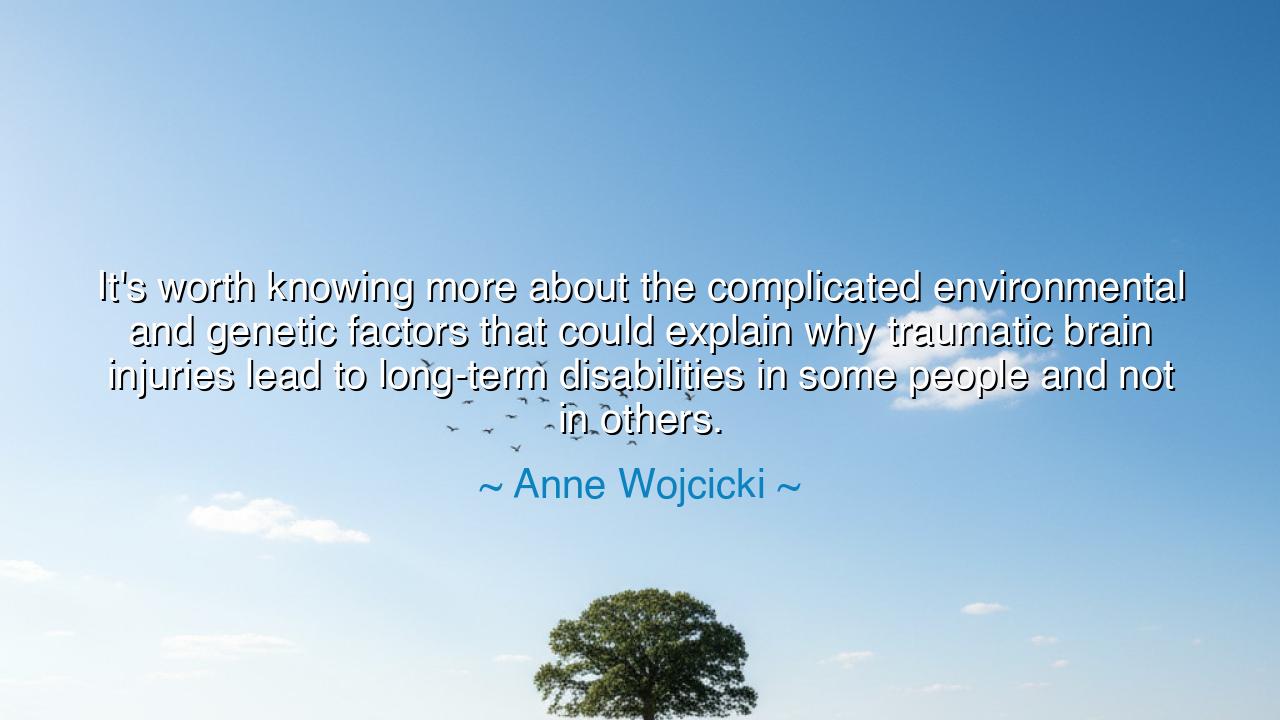
It's worth knowing more about the complicated environmental and
It's worth knowing more about the complicated environmental and genetic factors that could explain why traumatic brain injuries lead to long-term disabilities in some people and not in others.






Hear, O seekers of knowledge, the wise words of Anne Wojcicki, who proclaimed: “It’s worth knowing more about the complicated environmental and genetic factors that could explain why traumatic brain injuries lead to long-term disabilities in some people and not in others.” In this statement lies both humility and urgency: humility, because the human body is a mystery whose workings are still hidden from even the most learned; urgency, because the lives of many depend upon our willingness to unravel that mystery with patience and courage.
The meaning of her words is this: not all men and women suffer alike under the same blow. Some endure a traumatic brain injury and recover, rising once more to walk, speak, and think as before. Others, struck by a similar fate, find their lives forever altered, burdened with confusion, memory loss, or pain that lingers for decades. Why this difference? Wojcicki points us to the twin forces of genetics and environment, the inheritance of our blood and the shaping hand of our surroundings. Each life is unique, and the intersection of these factors determines whether resilience or fragility will prevail.
The ancients marveled at such mysteries. The physician Hippocrates observed that some men, after injuries, healed quickly, while others faltered, though the wounds seemed alike. He knew not of DNA, nor of the molecular dance within cells, but he saw the hand of nature and nurture intertwined. Even then, it was clear that no single cause could explain the destiny of the wounded—that a man’s constitution, his habits, and his environment all played their part in his recovery or decline.
History too gives us examples. Think of the soldiers who returned from the battlefields of World War I, shattered by concussions and blasts. Some recovered in time, returning to work and family. Others suffered what was then called “shell shock,” the trembling, nightmares, and broken spirits that haunted them long after the guns were silenced. In modern terms, we see this as a complex weaving of injury, genetic predisposition, and environmental stress. The battlefield wrote itself differently upon each soul, though the outward trauma appeared the same.
Wojcicki’s words also remind us that such knowledge is not idle curiosity. To understand the genetic and environmental factors is to open the door to better treatments, better prevention, and greater compassion. If we can learn why some are more vulnerable, we may develop medicines, therapies, or environments that protect them. And if we can see the hidden burdens carried in silence, we may extend patience and understanding to those whose wounds are invisible but no less real.
The lesson for us is this: never assume that suffering is uniform, nor that healing is simple. Recognize that every person’s body and soul respond differently to the storms of life. Be patient with the afflicted, for their struggle may be deeper than you know. Support the quest for knowledge, for in every discovery lies the power to lessen human pain and to restore dignity to those who have been cast down by injury.
Therefore, O listener, take these words into your heart. If you are one who has endured injury, know that your path is unique, and that your struggle is not weakness but the mark of battle endured. If you are one who serves others, whether as healer, teacher, or friend, remember to see beyond the surface, to honor both the seen and unseen wounds. Support the pursuit of science, which seeks not only knowledge but the healing of mankind.
So let Wojcicki’s words endure as both wisdom and charge: the fate of the injured is written not by one cause alone, but by the dance of genetics and environment together. Let us learn, let us care, and let us labor, so that in time, fewer shall be broken, and more shall rise whole again from the trials of life.






AAdministratorAdministrator
Welcome, honored guests. Please leave a comment, we will respond soon